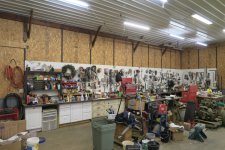MapleLeafFarmer
Platinum Member
- Joined
- Jun 20, 2011
- Messages
- 684
- Location
- Canada
- Tractor
- lots including Kubota B's, L's, cat, etc.. over many years
metal pail w/ lid full of water for dirty rags. Here it is code and I know a work shop just a few weeks ago that had a rag fire because pail was not full of water and did not have a cover.
timer on the Air compressor so it shuts down after you leave. Depending on size if a small 120 a simple bathroom fan timer works perfectly. Otherwise also 240v timer cheap. Some are mechanical so simple twist of the knob. Others are digital just press a button and will be active for whatever programmed.


Motion detector flood light. Great when I walk in the barns at night no fumbling for a light switch and a little extra security.
if electric garage door going to be used don't forget a 120v plug on the ceiling near where the door opener will be mounted.
split receptacles at the work bench so multiple things can be plugged in on different circuits.
isolated ground receptacle for the radio as I hate the static while i am listening to tunes.
multiple height work benches as I got older sometimes I need stuff higher / closer to my face as I don't see well as I used to. Don't need to bend over as much when bench surface 5' high for fine duty work.
I also like a small fan on a timer. I installed a small fan from a hog barn on a timer and and if I want to vent the shop for a couple of hours after I leave and lock up a quick twist of the timer and the fan runs for a couple of hours after I leave then shuts off automatically
timer on the Air compressor so it shuts down after you leave. Depending on size if a small 120 a simple bathroom fan timer works perfectly. Otherwise also 240v timer cheap. Some are mechanical so simple twist of the knob. Others are digital just press a button and will be active for whatever programmed.
Motion detector flood light. Great when I walk in the barns at night no fumbling for a light switch and a little extra security.
if electric garage door going to be used don't forget a 120v plug on the ceiling near where the door opener will be mounted.
split receptacles at the work bench so multiple things can be plugged in on different circuits.
isolated ground receptacle for the radio as I hate the static while i am listening to tunes.
multiple height work benches as I got older sometimes I need stuff higher / closer to my face as I don't see well as I used to. Don't need to bend over as much when bench surface 5' high for fine duty work.
I also like a small fan on a timer. I installed a small fan from a hog barn on a timer and and if I want to vent the shop for a couple of hours after I leave and lock up a quick twist of the timer and the fan runs for a couple of hours after I leave then shuts off automatically



